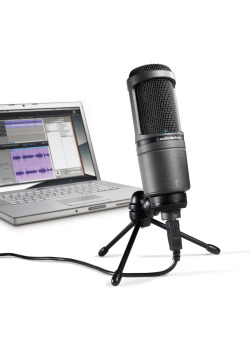
It’s actually pretty easy to start recording on your computer and it’s relatively inexpensive since most people already have one. Even a computer that is several years old can be powerful enough to get started provided you use the right software and can work around any potential limitations. Many computers have built in microphones and all have headphone outputs so you don’t need a ton of additional hardware to get started but you will probably outgrow these limited accessories pretty quickly. Here’s a quick guide for some essential gear that won’t break the bank
Input
As I said above, a built-in microphone will get you started but that’s about it. Built-in microphones often sound very compressed and they have a very limited frequency response range. They are also rather noisy so getting a better input device is possibly the thing to do first.
There are several options here but the two simplest ones are a USB recording microphone or an audio interface that can be used with any microphone you may already have access to. There are several really nice USB microphones. I use an Audio Technica 2020 USB but I have some friends that swear by the Blue Snowball. There are other models from these companies as well as numerous models from other manufacturers like Shure, Samson, Apogee, and AKG. Many of these microphones feature large-diaphragm condensors and those are very good for recording saxophones and woodwinds in general. Depending on the model and what computer you are using (Mac or PC) you may have to install a driver but these things are pretty painless and you get good results. For the most part, these microphones are made for audio podcasting and Internet radio but they’re very workable for getting started.

While I do have a USB microphone I only use it when I’m being really lazy or when I’m traveling. My son actually uses it more when he works on his You Tube stuff. What I prefer is the next step up and that’s a dedicated audio interface. These are better for several reasons. First, they usually allow multiple simultaneous input channels and that’s important if you want to try to record other instruments at the same time or if you need to record drums. Second, they also provide an upgraded output section over the headphone jack built into your computer. Third, many of them also provide a MIDI in and out in addition to the audio and that’s good if you want to access soft synths in your computer or if you want to sequence into an external sound module. I have several of these but the one I use most is the M-Audio Fast Track Ultra. It’s an 8 in/8 out interface with MIDI, 4 mic preamps, built in digital signal processing (DSP) and routing, and 2 separate headphone sends. You don’t have to get anything nearly that elaborate but you will probably want something with 2 ins and 2 outs, MIDI, and it helps if it has XLR inputs although you could also get a separate mic preamp but that’s more money.
If you’re using these things on a Mac then they are pretty much plug and play. On a PC you will want to make sure that the interface has available ASIO (Audio Stream Input/Output) drivers to cut down on the latency. Latency is the lag between the input and the output while recording and shorter is not only better, it’s practically a requirement. One tip, if there are no ASIO drivers for your interface you can try downloading ASIO4all drivers. Of course, no matter what you will need a microphone (or microphones) and cables to make this system work. It’s more money but it’s also more flexible.
Well that’s enough for one day. I will get to the output section in a future post and then I’ll move on to software. After that we’ll see how it goes.